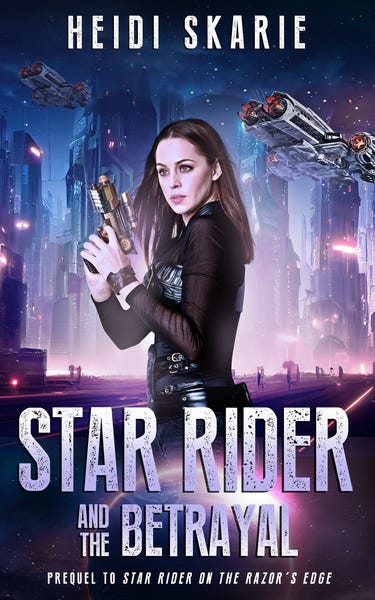Greetings, my fellow humans! And robots!
Before we get to today’s flash fiction story, I want to let you know about some changes to this newsletter. I’m transitioning back to a model where it will be entirely free. Those of you with paid subscriptions should get a refund for your most recent payment within a week or so.
If you’re a fellow Indie Author, who has been tracking my business decisions and are curious to know why, email me.
For everyone else, nothing really changes. :) I’ll still be writing flash fiction as often as I’m inspired, but I will be encouraging you all to comment/like on Substack. In this free model, all of you can do so—not just paid subscribers.
If you want to pay me (because you’re like me, and agree that artists of all kinds should be paid for their work), just buy my books and stories and tell others to do so as well!
Those books and stories are:
Links: Lunar Logic | Robot Galaxy Series | Final Orbit | Objective Reality
To ensure I keep writing more, especially in the Robot Galaxy Series, check out my for-real-it’s-really-forthcoming Kickstarter! Head over to the pre-launch page and hit that “Notify on launch” button right now so you’ll be notified the minute it launches!
…and make sure to read to the end and check out some of the indie authors.
One of the best things about my day job, is the real-world science and engineering. Early in my career, I did a lot of work in a subfield that we call “Flight Dynamics.” Flight Dynamics is all about orbits and trajectories of stuff in space.
My work was pretty basic. I had to develop software systems to keep track of a satellite in a very simple Low Earth Orbit (LEO) and calculate the orbit-raising burns the satellite would need to perform periodically to maintain that orbit.
If you have any knowledge of physics, know that this was simple two-body problem stuff.
But recently, my work has me thinking about and working on orbits and trajectories for three bodies. No, this is not a reference to the book “The Three Body Problem” by Liu Cixin (which I highly recommend) or the Netflix show based on the book (which I highly recommend only if you have a strong stomach).
As we move around a system, like the Earth and the Moon—not just orbit the Earth—we have to think about three bodies. The Earth, the Moon, and the vehicle—whether it’s a satellite, the Orion capsule, or some future spaceship.
There are points in space where the pull of the Earth and Moon are somewhat equivalent. We call these Lagrange Points. Every two-body system has them. And we like to put satellites at those points (adding in that third body). But, when we say “at” those points, we’re over-simplifying. Most missions “at” those points are really in orbit around that point.
The first mission I ever worked on, the Advanced Composition Explorer, is still at a Sun-Earth Lagrange Point in a halo orbit about that point. The James Webb Space Telescope is in a halo orbit around another Sun-Earth Lagrange Point.
There isn’t just one kind of halo orbit about these points, either. There are all kinds of periodic orbits around these points.
When I say I work on this stuff, lately, I manage projects and other engineers are doing the real detailed work in flight dynamics. One recent day while I was discussing these orbits with a colleague, I learned that there are orbits called “Butterfly orbits” and “Dragonfly orbits” around these points.
My brain immediately thought of how in Star Trek, 99% of the time, we hear the order: “Put us in standard orbit!” What the heck is ‘standard orbit’? There’s no such thing. Why don’t we ever hear them put the ship in a star-synchronized orbit? Or in a highly elliptical orbit? Okay, every now and then we hear about going over a pole—but I’m not recalling them saying the words “polar orbit.”
Anyhoo—I like the thought of some captain issuing the order: “Put us in a Butterfly Orbit around that point!”
I took a note that I needed to write a story around this, and well, here we are.
(PS: I wanted to share a link with y’all from NASA’s JPL that visualized all these kinds of orbits, but it’s not working for me as I write this, but maybe it will be when you see it: https://ssd.jpl.nasa.gov/tools/periodic_orbits.html )
Please enjoy the resulting flash fiction story!
Not Your Standard Orbit
“Helmsman, put us in Butterfly Orbit.”
This was the moment. Ensign Rowe Rivers was ready. All through his time at the academy studying flying, he’d learned—and flown—all possible orbits that one could achieve with a starship, shuttlecraft, or even drop a probe into.
Most of this was just for exercise, as captains ordered their helmsperson into Standard Orbit 97.2% of the time. But then, there was the other 2.8%.
Most of that 2.8% was achieved by one notorious captain. Captain Sebastian Voss.
The rumor was that the word ‘standard’ was neither in his personal vocabulary nor allowed to be uttered in his presence on his ship. To do so earned one time cleaning up after his pet varch—a creature that appeared to be half cat, half lizard, but pooped as if it had elephant-sized intestines with a smell to match.
Rowe—who could plot out and fly standard orbits in his sleep—was thrilled that his first posting after graduation was aboard Captain Voss’s ship, the TSS Ecliptica.
They had spent the last few days cruising towards this star system. And now that they were here, Captain Voss had them approach the sixth and largest planet. It was a hot, gaseous mess and entirely uninhabitable, but its primary moon, also uninhabitable, hosted a moon of its own. And that latter moon was their mission—although the rest of the details as to why they were here remained unknown to Rowe.
“Butterfly orbit, yessir,” Rowe said, while letting his fingers dance over the console.
“Or dragonfly orbit. You choose.”
Rowe’s fingers immediately stopped. “Sir?”
“Did you not hear me, Ensign Rivers?”
Rowe had absolutely heard his captain and noted that, until now, Voss had only ever referred to him as ‘helmsman.’ Using his rank and his name got the point across that Voss knew exactly who his helmsman was.
But leaving the choice of orbits—butterfly or dragonfly—up to him made about as much sense as letting the varch pick out the captain’s next meal.
While both orbits were named after creatures long extinct on the homeworld, that’s where their similarities ended.
The dissimilarities started with the fact that butterfly orbits were inherently stable around a two-body gravitational equilibrium point and dragonfly orbits were unstable, which simply meant that they’d use a lot more fuel to maintain that orbit.
Rowe was skilled enough to direct the computer to calculate the precise maneuvering thruster burns to steer the ship into the unusual orbit, but he’d never been asked to make the decision himself.
He felt frozen in space and time, his brain racing through all his options. He could say something meek like, ‘Me, sir? You want me to choose?’ but imagined the captain roaring at him in front of the bridge crew, ‘Did you not just hear me give you the choice?’
He could admit he didn’t know how to choose and face similar brandishing with his captain then questioning why he was on the bridge piloting the fleet’s flagship.
Rowe played out several of these fictional conversations in the space of a few seconds and forced his fingers to stall by preparing calculations for each.
Finally, he knew what to say.
“Sir, to make a decision, I need more information about our mission here.”
Captain Voss smiled. Or was that more of a smirk? Either way, Voss looked pleased and not irritated.
“Excellent, helmsman. That was the correct response to my test.”
“Test?” Rowe, feeling confident now, let a little confusion show on his face.
“Yes. They tell you at the academy some garbage that it’s good to admit when you don’t know something. But in reality, it’s much more nuanced than that. A good officer doesn’t just throw their hands up and say, ‘I don’t know.’ A good officer analyzes the information they have, identifies what they lack, and asks for what they need.”
Rowe nodded.
The captain looked over to the ship’s XO and said, “I need to call command and let them know we’re here. I’ll be in my office. You have the bridge.”
With that, he swaggered out.
The first officer, Commander Tarian Cross, stood up and said, “Butterfly Orbit. For now, we don’t need to expend any extra fuel.”
“Butterfly orbit, yes ma’am,” Rowe responded and continued to tap at his console using his calculated results from moments ago to guide the ship into the requested orbit.
The commander glanced in the direction the captain had walked off to. “And join us and some of the other senior officers in the briefing room in 20 minutes. You’ll be filled in on all the mission details then.”
When she sat back down, she sat in the captain’s chair.
Rowe wondered how long it would be until he was asked to sit there, even temporarily. Maybe not long at all if he kept himself on the right trajectory. The one day, maybe, he’d be the one giving orders like these, leaving his own helmsman equally thrilled and terrified.
What did you think of the story?
I love feedback, especially if you loved the story! ;) Simply reply and let me know what you think! Or do any of these things:
And of course, subscribe so you get notified when I post new stories!
I routinely participate in newsletter swaps with other Indie Authors. This is one of the ways we help each other get the word our about our books. So please — check these folks out and see if they’re for you!
You might enjoy this story by Heidi Skarie:

I also participate in Group Promos as well. Here are the ones I’m in that you should definitely check out and see what other stories and authors you might enjoy!
My co-hosts and I took a little holiday break at BIG Sci-Fi podcast. So now is a great time to catch up on some of our past episodes. Did you know that we’ve interviewed a lot of sci-fi authors and writers?
John Scalzi
Andy Weir
David Gerrold
Keith R.A. DeCandido & Dayton Ward
Michael Jan Friedman
Lisa Klink
Robb Pearlman
Davy Perez
David Mack
Christopher D. Abbott
Phyllis Strong
(and me! my co-hosts interviewed me once)
We’re on all the major podcast platforms:
Spotify | Amazon | Apple | others…
What’s next?
WRITING. I’m continuing to focus on writing for the next couple of months, particularly on my Lunar Logic sequel. A lot of the T-Set books (the follow-on the The Robot Galaxy Series) has been drafted and I’m waiting on my Kickstarter to complete those.
I’ve got other ideas and things lined up for new series as well… no shortage of ideas here, just time.
All always, thanks for reading all of my ramblings. I hope you’re finding it useful. Remember you can reply anytime with questions/comments/feedback!
Until next time… be kind, be well!
-Adeena








Nice, one little question, what does the {T} in TSS stand for? I don’t remember seeing it in Star Trek. Also interesting explications on orbits, I remember thinking standard, standard for what or where? Keep up the good work, maybe we’ll meet on STTC in 27 for STTNG’s 40th anniversary.
Oh, I love it! Makes me want to read more. Only please - "we're here", not "where here".